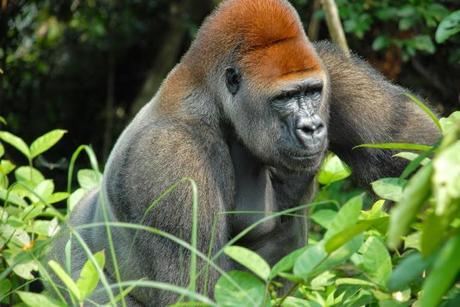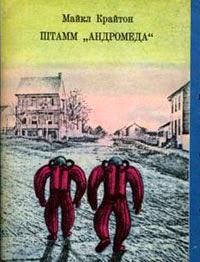It is a terrible disease, sneaky and final. Sneaky because it take up to 21 days to show its face, and final because the death rate can be upwards of 90%. The current outbreak has been showing a death rate of 55-60%. By comparison, the Spanish Influenza mortality rate was 2.5-3%.
In this NatGeo article from September 2014, we read,
Since the first outbreaks in Africa in 1976, three of the five species of Ebolavirus have accounted for almost all cases of the disease seen below: the Sudan, Bundibugyo and Zaire species. A fourth species (Taï Forest) caused one nonfatal case in Cote d’Ivoire in 1994. A fifth (Reston) has not yet been transmitted to humans.

Silverback Gorilla, CC
Ebola is named after the river in the area it first made an appearance. It was discovered in green monkeys and then gorillas in 1975-1976. This article from 2006 reports on the devastation the disease has been causing in gorillas.Ebola Killing Thousands of Gorillas, Study Says
for National Geographic News, December 7, 2006
The Ebola virus is marching steadily across western and central Africa, wiping out more than 90 percent of the gorillas in its path and threatening the species with extinction, a new study says. About 5,000 gorillas were killed by the virus in one study area alone, according to results to be published in tomorrow's issue of the journal Science. Ebola causes a hemorrhagic fever, resulting in massive internal and external bleeding that kills within two weeks of symptoms appearing. There is no known cure, and in humans the mortality rate is around 80 percent. The virus is named after the Ebola River in the Democratic Republic of the Congo, near where the first known outbreak occurred in 1976.Back when Ebola was first discovered both in primates and in humans, it sort of freaked out the medical world. It popped up out of nowhere and to this day they don't quite know where it emerged from or why. Dr. Karl Johnson wrote in 1979 in the Annals of Internal Medicine,
Ebola Virus and Hemorrhagic Fever: Andromeda Strain or Localized Pathogen?
KARL M. JOHNSON, M.D.
The nearly simultaneous occurrence of major epidemics of acute hemorrhagic fever with high mortality in Sudan (1) and Zaire (2) during late 1976 serves as a poignant reminder that infectious "plagues" have not been, nor are they likely soon to be, eliminated from our world. The causative agent of these epidemics was found to be a virus new to science and was named Ebola after a small river near Yambuku, Zaire, a disease epicenter where the initial isolate was made.... Until effective vaccines are developed, careful management of patients and surveillance of their close contacts offer the only rational way to deal with agents sometimes viewed as Andromeda's children."
 Thirty-five years later an effective vaccine is still not developed and the careful management of patients showing symptoms kind of went out the window in Dallas this week as a man recently returned from Liberia was sent home from the hospital he arrived at for treatment. He went back two days later, in an ambulance, after a chaotic scene outside his apartment building where witnesses say "he was vomiting all over the place." The ambulance he was delivered to the hospital in is now under quarantine as a bio-hazard. The patient's condition has been upgraded to serious, which is great, considering the only drug available, ZMapp, has been used up and further doses are not available at this time. Perhaps Thomas Eric Duncan will bounce back. I hope so. It turns out he had been a chaufferur in Liberia for the last two years before abruptly quitting in September and walking out without notice, His boss had no idea where he was until he saw Duncan in the news as the US Ebola patient.
Thirty-five years later an effective vaccine is still not developed and the careful management of patients showing symptoms kind of went out the window in Dallas this week as a man recently returned from Liberia was sent home from the hospital he arrived at for treatment. He went back two days later, in an ambulance, after a chaotic scene outside his apartment building where witnesses say "he was vomiting all over the place." The ambulance he was delivered to the hospital in is now under quarantine as a bio-hazard. The patient's condition has been upgraded to serious, which is great, considering the only drug available, ZMapp, has been used up and further doses are not available at this time. Perhaps Thomas Eric Duncan will bounce back. I hope so. It turns out he had been a chaufferur in Liberia for the last two years before abruptly quitting in September and walking out without notice, His boss had no idea where he was until he saw Duncan in the news as the US Ebola patient.The Andromeda Strain referred to in the 1979 Annals of Internal Medicine article, is the title of a 1969 novel by Michael Crichton. The Andromeda Strain is a techno-thriller novel documenting the efforts of a team of scientists investigating the outbreak of a deadly extraterrestrial microorganism in Arizona that rapidly and fatally clots the blood in most humans, while inducing insanity in a small handful of others. (Wikipedia)
The Dallas apartment complex where Duncan was believed to be staying was cordoned off Wednesday, and the management was turning away visitors. TV cameras lined the fence of the parking lot, and at least one helicopter hovered overhead.

Andromeda Strain, Russian release, 1971
The intense news interest in the story is indicative of the intense viewer interest in the story. This kind of interest was evidenced almost immediately upon publication of Crichton's Andromeda novel,"Written while Michael was still in medical school, it caused an immediate sensation: partly because the author was still in his twenties; partly because it focused on a biological crisis when most people were thinking about nuclear crises..."The Dallas news outlets are reporting the Ebola patient, Thomas Eric Duncan, after he was sent home, had contact with close friends and family, including several school children who attend different schools. Several of the kids are being monitored, but parents are still pulling their children from school.
Twitter, Jake Tapper: "80 people being monitored for Ebola in Dallas: the patient, his contacts and anyone they contacted, officials say." via @cnnbrk
The first person diagnosed with the Ebola virus in the U.S. wasn't appropriately treated for suspected infection until after a relative personally called the Centers for Disease Control and Prevention, his nephew told NBC News on Wednesday night. ... Weeks said the CDC referred him to the Texas Department of Health and Human Services, which spoke to him and then took appropriate action. "I called the CDC and they instructed me of the process, and that got the ball rolling," Weeks said.
A second person is being monitored for Ebola, "Let me be real frank to the Dallas County residents: The fact that we have one confirmed case, there may be another case that is a close associate with this particular patient," he said. "So this is real. There should be a concern, but it's contained to the specific family members and close friends at this moment."
Five children from four DISD [Dallas Independent School District] campuses were possibly exposed to the virus. [Superintendent] Miles said none of the students have exhibited any symptoms of Ebola at this time.Yeah, but doesn't it take up to three weeks for symptoms to show? So of course after one day they would not be showing symptoms. Meanwhile in Hawaii, another possible Ebola patient is being monitored.
Ebola fears quarantine man in Hawaiian hospital: The unnamed patient has yet to be tested for the deadly virus, but Hawaii Department of Health officials said Wednesday they quarantined him at a Honolulu hospital after he showed symptoms.At some point, the pale horse of pestilence is going to ride. (Revelation 6:7-8). The Seals will not be broken until after the rapture but we could be seeing a set-up. Or not. We never know at the time whether this is an outbreak or not. In Fort Riley Kansas in 1918 did they have a clue that when the camp cook came down sick he would be nearly the first victim of a worldwide Spanish Influenza pandemic that would eventually kill three to five percent of the entire population?
It infected 500 million people across the world, including remote Pacific islands and the Arctic, and killed 50 to 100 million of them—three to five percent of the world's population—making it one of the deadliest natural disasters in human history...A large factor in the worldwide occurrence of this flu was increased travel. Modern transportation systems made it easier for soldiers, sailors, and civilian travelers to spread the disease. In the United States, the disease was first observed in Haskell County, Kansas, in January 1918, prompting local doctor Loring Miner to warn the U.S. Public Health Service's academic journal. On 4 March 1918, company cook Albert Gitchell reported sick at Fort Riley, Kansas. By noon on 11 March 1918, over 100 soldiers were in the hospital. Within days, 522 men at the camp had reported sick. By 11 March 1918 the virus had reached Queens, New York.The Dallas (and Honolulu) situation is of concern, as is the African Ebola situation in general. People are scared of pestilential disease, it is creepy in the way that the 1970s shark movie Jaws caught our deepest fears of being hunted while swimming in unfamiliar habitats. A primal fear, different from the horror of nukes falling on us, the enemy of disease invades our bodies and destroys from the inside.
I can't help but remember that another of the books that caught my attention so deeply when I was a teenager, Stephen King's The Stand, was about a superflu that killed 99% of the world population within 2 months. It, also, began in Texas, by a man named Campion...
